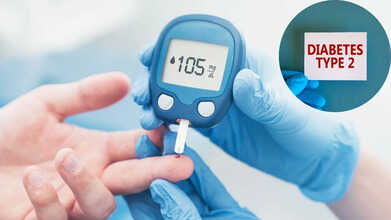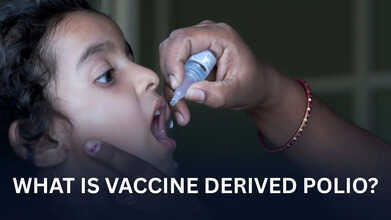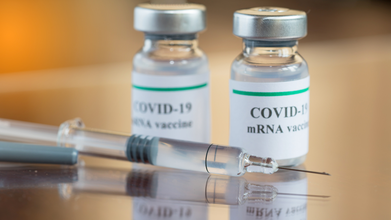- Health Conditions A-Z
- Health & Wellness
- Nutrition
- Fitness
- Health News
- Ayurveda
- Videos
- Medicine A-Z
- Parenting
- Web Stories
Blood Sugar Levels In Type 2 Diabetes: What Counts As High, Low, Or Normal?

Credits: Canva
Type 2 diabetes is a long-term condition where your body either doesn’t produce enough insulin or can’t use the insulin it makes properly, causing blood sugar levels to rise. Keeping an eye on your blood sugar is essential for managing the condition and protecting your overall health.
A blood sugar chart can help you understand what’s normal, too high, or too low. By getting familiar with these ranges, you can work with your doctor to maintain healthy levels and reduce the risk of complications. Below, we break down everything you need to know about type 2 diabetes.
What is Type 2 diabetes?
Type 2 diabetes (T2D) occurs when blood sugar (glucose) remains consistently high. Normal blood sugar levels fall between 70 and 99 milligrams per deciliter (mg/dL). If undiagnosed, Type 2 diabetes often shows levels of 126 mg/dL or more.
T2D happens because the pancreas doesn’t produce enough insulin, the body can’t use insulin effectively, or a combination of both. This differs from Type 1 diabetes, which arises when the immune system attacks the pancreas, leaving the body unable to produce insulin at all.
How Common Is Type 2 Diabetes?
Type 2 diabetes is widespread. Over 37 million people in the U.S. have diabetes (around 1 in 10), with 90–95% of cases being T2D. Globally, it affects roughly 6.3% of the population. While it’s most common in adults over 45, younger adults and even children can develop it.
Blood Sugar Range For Adults With Type 2 Diabetes And Children With Type 2 Diabetes
The American Diabetes Association recommends the following ranges for adults with type 1 or type 2 diabetes and children with type 2 diabetes:
| Time | Recommended Blood Sugar Range |
| Fasting (before eating) | 80 to 130 mg/dL |
| 1 to 2 hours after meal | Lower than 180 mg/dL |
Is Type 2 Diabetes Genetic?
T2D has complex causes, but genes play a significant role. If one biological parent has T2D, your lifetime risk is around 40%, and if both parents do, it rises to 70%. Scientists have identified over 150 DNA variations linked to T2D risk, some increase the chance of insulin resistance or reduced insulin production, while others influence obesity risk. These genetic factors interact with lifestyle and health habits to determine overall risk.
How is Type 2 Diabetes Diagnosed?
Doctors use several blood tests to confirm T2D:
- Fasting plasma glucose test: Measures blood sugar after an eight-hour fast. A result of 126 mg/dL or higher indicates diabetes.
- Random plasma glucose test: Measures blood sugar at any time without fasting. A reading of 200 mg/dL or higher signals diabetes.
- A1C test: Reflects average blood sugar over the past 2–3 months. A level of 6.5% or higher indicates diabetes.
What Is A1C?
A1C shows your average blood sugar for the past three months. When sugar circulates in your blood, it attaches to a protein called hemoglobin. Higher blood sugar levels result in a higher percentage of hemoglobin coated with sugar. Your A1C result helps indicate whether your blood sugar is normal, prediabetic, or diabetic.
The chart below shows where your A1C result stands, whether it is within a healthy range or could indicate prediabetes or diabetes.
| Diagnosis | AIC Result |
| Normal | less than 5.7% |
| Prediabetes | between 5.7% and 6.4% |
| Diabetes | 6.5% and higher |
What Is Vaccine-Derived Polio And How Is It Triggering New Polio Cases In India?

Credits: Canva
A two-year-old child from Meghalaya’s West Garo Hills district reportedly tested positive for polio in 2025, a highly contagious and potentially fatal disease that once crippled millions before being nearly wiped out by vaccines.
Officials from the Union Health Ministry confirmed that the infection was vaccine-derived, stressing that India’s polio-free status remains unaffected. But what exactly does “vaccine-derived” mean, and is it dangerous? Can such a case spread from one person to another? Let’s break it down.
What Is Vaccine-Derived Polio?
A vaccine-derived poliovirus (VDPV) is a mutated form of the weakened live virus used in the oral polio vaccine (OPV). According to the Centers for Disease Control and Prevention (CDC), if this weakened strain continues to circulate among communities with poor vaccination coverage or replicates inside a person with a weak immune system, it can revert to a version capable of causing paralysis and illness.
Interestingly, the oral polio vaccine (OPV) has played a crucial role in eliminating wild poliovirus globally. It contains one or more weakened strains of the virus and is administered as oral drops, which help build immunity in the gut, stopping the virus from spreading. However, when too few people are vaccinated, the weakened virus can continue moving from person to person, mutating over time, and eventually regaining its disease-causing ability.
However, it is important to remember that polio drops are safe and have helped nearly every country eliminate the disease. Still, in extremely rare cases, especially among children with weak immune systems, the vaccine strain can cause infection.
Types Of Polio Vaccines
There are two kinds of vaccines used to protect against polio, one given orally and the other through injection.
Oral Polio Vaccine (OPV):
This is the most widely used vaccine in India. It contains a weakened version of the poliovirus that helps the body build immunity without causing illness. It is administered orally, usually as drops, and is used during mass campaigns such as National Immunization Days.
Inactivated Polio Vaccine (IPV):
IPV, on the other hand, contains a killed version of the poliovirus and is given as an injection. It forms part of India’s routine immunization schedule and is often delivered in combination with other vaccines.
In India, both vaccines are used, though OPV remains preferred because it’s simple to administer during large-scale drives.
Vaccine-Derived Polio Cases Detected In India
India’s last recorded wild poliovirus case occurred years ago, but in 2024, a two-year-old child in Meghalaya was confirmed to have vaccine-derived polio. Officials clarified that this does not affect the country’s polio-free certification, since the virus involved was vaccine-derived rather than wild.
Earlier instances have been reported as well. In 2011, a vaccine-derived virus was detected in West Bengal’s Howrah district. Another case emerged in Beed district, Maharashtra, where an 11-month-old boy with an immune disorder developed brain lesions after contracting the vaccine-derived strain and sadly passed away.
In 2021, Kerala also documented a rare transmission case: a seven-month-old baby with Severe Combined Immunodeficiency (SCID) received the oral vaccine but couldn’t clear the weakened virus from his system. The virus was later passed to his father through the fecal-oral route, as reported by The Times of India.
Why Are Vaccines Triggering Fresh Polio Cases In India?
Vaccine-derived polio tends to appear in communities where immunization coverage is low. The weakened virus from OPV can circulate in such areas, undergo genetic changes, and, over time, transform back into a version capable of causing paralysis, the World Health Organization (WHO) explains. When this mutated strain starts spreading in the community, it’s known as a “circulating vaccine-derived poliovirus” (cVDPV).
In India, the few vaccine-derived cases reported so far have primarily been seen in children with weak immune systems, who are unable to fight off even the weakened vaccine virus. Poor sanitation and incomplete vaccination coverage further increase the risk of such mutations.
Can Vaccine-Derived Polio Be Prevented?
The oral polio vaccine remains highly effective at preventing the spread of the virus from person to person, and it is easy, drop-based delivery has made it the foundation of the global eradication effort. However, one drawback is that, on rare occasions, it can cause infection or transmit the weakened virus to others, as noted by the CDC.
To reduce this risk, many experts advocate switching entirely to the inactivated polio vaccine (IPV). Yet IPV has its own challenges: it requires trained medical staff for injection, which could lower immunization rates, and unlike OPV, it does not stop virus transmission through the gut.
Countries such as the United States and Canada have already moved entirely to IPV. India, however, continues to use both forms, IPV as part of routine childhood immunization and OPV for children under five during Pulse Polio campaigns.
Polio vaccination remains the best protection against both wild and vaccine-derived strains. Maintaining high IPV coverage is essential to keeping India and the rest of the world polio-free, ensuring that even rare mutations never regain a foothold.
mRNA COVID Vaccines Found To Help Cancer Patients Live Longer: Can This Be The Ultimate Cancer Cure?

(Credit-Canva)
COVID vaccines have often been at the center of discussions, mostly for their side effects and potential risks. But this time the spotlight is on something positive - COVID vaccine is being linked to prolonging the life of cancer patients. But not every COVID vaccine, only mRNA.
Scientists at the University of Florida and the University of Texas MD Anderson Cancer Center discovered something very important. They found that people with serious lung or skin cancer who got an mRNA COVID-19 vaccine around the time they started their anti-cancer treatment, which is immunotherapy, lived much longer than those who didn't get the shot. Specifically, the vaccine seemed helpful if it was given within 100 days of starting the cancer treatment.
Also Read: Is Bubble Tea Putting Your Health at Risk? Experts Warn About Lead Exposure
This discovery is a huge leap forward in the research to use mRNA technology—the same tech used for the COVID shots—to teach the body's natural defense system to fight cancer. It builds on previous studies and brings us closer to a potential universal cancer vaccine that could make existing cancer drugs work even better for more people.
Can mRNA Vaccine Cure Other Diseases Than COVID?
The new study, which was written about in the journal Nature, comes from eight years of work by Dr. Sayour on mixing tiny fat bubbles with mRNA. mRNA is a natural material in your body that carries the blueprint for making proteins.
Dr. Sayour's lab previously had an unexpected finding: to make the immune system strongly attack a tumor, they didn't have to target a specific piece of the cancer. Instead, they could just boost the immune system as if it were getting ready to fight a virus. This led to an experimental mRNA shot (similar to the COVID vaccines) that, when mixed with standard cancer drugs, strongly fought tumors in mice.
This success made another team member, Dr. Adam Grippin, wonder: Could the standard COVID-19 mRNA vaccine act the same way as their experimental "nonspecific" one? To find out, the researchers looked at the medical records of patients with advanced lung and skin cancers treated between 2019 and 2023.
What Are mRNA Vaccines And Which Ones Are Approved For Usage?
The Mayo Clinic explains that the mRNA vaccine gives your cells a set of instructions on how to build the harmless spike protein that is on the COVID-19 virus. The vaccine sends the mRNA into your muscle and your muscle cells or other defense cells read these instructions and start making the spike protein. This is how your body prepares to protect you from the virus. Moderna and Pfizer-BioNTech are both mRNA vaccines available in the US.
Also Read: Not All Antidepressants Affect Your Body The Same; Here’s What You Need To Know About Side Effects
How Have mRNA Vaccines Helped Our Health?
These findings come from checking the medical files of over 1,000 patients. It's important to know that this is only the first look at the information. Scientists must confirm these results in a strict new study called a randomized clinical trial. If the results hold up, this study could change cancer treatment forever.
The study clearly shows how powerful mRNA medicines are. The findings also point to an unexpected benefit from the government's quick push for COVID-19 vaccines (called Operation Warp Speed), showing how that effort continues to help save American lives.
The data analysis showed that getting a COVID mRNA vaccine within 100 days of starting cancer drugs was linked to significantly longer lives. This was most true for patients whose bodies weren't expected to fight their tumors very well on their own.
For 180 advanced lung cancer patients who got the vaccine, the average survival time was nearly doubled, going from 20.6 months to 37.3 months, compared to patients who didn't get the shot. For patients with widespread skin cancer (melanoma), the average survival went up from 26.7 months to somewhere between 30 and 40 months. Importantly, getting non-mRNA shots, like the regular flu vaccine, did not change survival time.
Should mRNA Vaccines Become Cancer Treatment?
To make sure their findings were real, the UF researchers did experiments with mice, giving them immunotherapy drugs along with an mRNA vaccine for the COVID virus. These tests showed that the combination could make cancers that usually ignored treatment suddenly shrink and stop growing.
The next necessary step is to launch a big clinical trial to confirm these findings. If they are proven true, scientists could design an even better, general-purpose vaccine to help cancer patients. For people with late-stage cancer, the extra time they gain from this kind of treatment would be priceless. Dr. Sayour believes that even a small boost in survival, like 5% or 10%, means a huge amount to these patients, especially if this treatment can work for many different kinds of cancer.
World Polio Day: How the Polio Vaccine Became a Lifesaving Shield Against a Global Disease

Credits: Canva
In the 1970s, India faced nearly 200,000 polio cases each year. This was not unusual, before vaccines became widespread, diseases we now rarely think about, like polio, caused unnecessary death and immense suffering. Measles, for instance, claimed an estimated 2.6 million lives annually before its vaccine was introduced in the early 1960s.
To ensure every child benefits from vaccines and is protected from preventable diseases, we must learn from successful campaigns, including the global effort to eradicate polio.
Also Read: mRNA COVID Vaccines Found To Help Cancer Patients Live Longer: Can This Be The Ultimate Cancer Cure?
Since the global push to eliminate polio began in 1988, cases have dropped by 99.9%. India was officially declared polio-free on March 27, 2014, by the World Health Organization (WHO), following the last reported case of wild polio on January 13, 2011, and a subsequent three-year period without any new cases.
This marked one of the most formidable milestones in public health: India—and the entire South-East Asia Region was certified polio-free, despite limited resources and enormous challenges. On World Polio Day, we take a closer look at how the polio vaccine helped the world stop a global threat.
What is Polio?
Poliomyelitis, or polio, is a viral disease that in its early stages can cause fatigue, headaches, stiffness, and limb pain after exposure to the poliovirus, according to the World Health Organization (WHO). About one in 200 infections leads to paralysis, and 5–10% of those paralyzed may die if the disease immobilizes their breathing muscles. While polio mainly affects children under five, anyone who is unvaccinated is at risk.
In the 19th and 20th centuries, frequent polio outbreaks made it one of the most feared diseases in the United States. The deadliest outbreak occurred in 1952, claiming more than 3,000 lives, according to US public health data.
Also Read: Not All Antidepressants Affect Your Body The Same; Here’s What You Need To Know About Side Effects
Polio Affected Hundreds Of Thousands Of Americans
The United States faced its worst polio outbreak in 1952, with nearly 58,000 cases of paralysis and just over 3,000 deaths. Thanks to widespread vaccination, polio was eliminated in the country by 1979.
Polio Eradication In India
India launched the Pulse Polio Immunization Programme on 2 October 1994, at a time when the country accounted for nearly 60% of all polio cases worldwide. Two decades later, on 27 March 2014, India was officially declared polio-free by the World Health Organization, following the last reported case in Howrah, West Bengal, on 13 January 2011, according to WHO records.
The success of this campaign hinged on ensuring vaccines reached every child, including those in the most remote and vulnerable communities. Strong commitment at all levels, from policymakers and health authorities to frontline workers, partners, and community volunteers ensured that life-saving polio drops were delivered to children wherever they were, whether at home, in school, or while traveling.
About The Polio Vaccine
The first polio vaccine was developed in the early 1950s by Dr. Jonas Salk and approved for use across the United States in 1955. This injectable, inactivated polio vaccine (IPV) is still in use in some countries today.
In the late 1950s and early 1960s, Dr. Albert Sabin developed a second option: the oral polio vaccine (OPV). Introduced into the US immunization schedule in 1961, it was inexpensive and easy to administer, which helped it become the most widely used polio vaccine in national immunization programs around the world. While it’s no longer used in the US, it remains especially effective in developing countries.
The two main types of polio vaccines are:
Inactivated Polio Vaccine (IPV)
- Introduced in the US in 1955
- The only polio vaccine used in the US since 2000
- Given via injection, requiring a trained health worker and sterile equipment
Oral Polio Vaccine (OPV)
- Introduced in the US in 1961
- The most widely used polio vaccine globally
- Administered orally and can be given by trained volunteers
How Polio Vaccine Saved World From A Health Crisis
Polio vaccines have played a key role in eliminating the wild form of the disease from many parts of the world, including the Americas, Europe, Southeast Asia, and Africa, according to the World Health Organization (WHO). Czechoslovakia was the first country to show that nationwide eradication of wild poliovirus was possible, achieving this in 1960 after a strong vaccination campaign in which roughly 93% of children received the oral polio vaccine.
Despite these successes, wild poliovirus remains endemic in a few regions, notably Afghanistan and Pakistan.
© 2024 Bennett, Coleman & Company Limited

